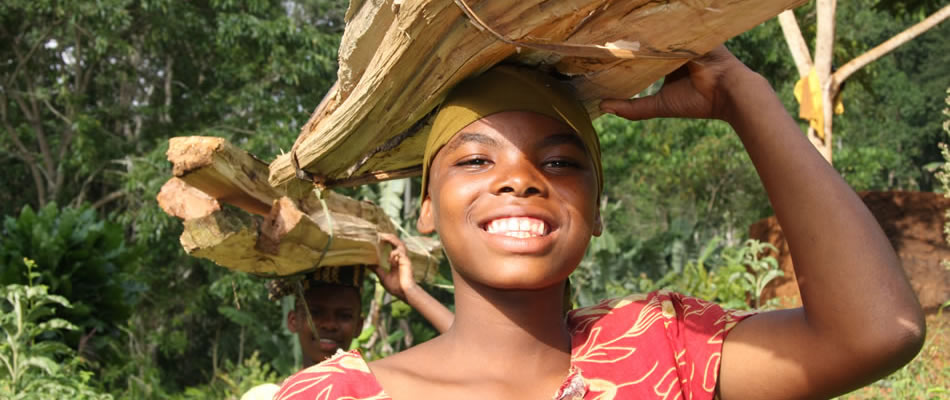Re-connecting high biodiversity forests in the East Usambara Mountains
The East Usambara Mountains are home to seven vertebrate species found nowhere else on earth. The forests also help to cool local climates, protect water sources and provide valuable forest products for local communities. The 384 km2 of remaining East Usambara forest is fragmented and threatened by agriculture. The combination of fragmentation and habitat loss threatens the survival of the mountain’s unique species and ecosystem services. To address this, the Tanzania Forest Conservation Group is supporting local communities to protect and restore the most threatened forests. By restoring ecological corridors, TFCG will help to re-connect the southern and northern forests.

East Usambara Mountains
East Usambara Mountains, a forest gemThe East Usambara Mountains have been described as the jewel in the crown of the Eastern Arc. With seven strictly endemic vertebrates and 35 Eastern Arc endemic vertebrates the mountains have an extraordinarily high level of endemism given their small area. The forests are also a vital source of fuel wood, building materials, food and water for the people that live there. The mountains are also an important source of water for the people of Tanga Town. The biodiversity of the East Usambara Mountains are under pressure from expansion of agricultural land, fire, logging, artisanal mining, commercial firewood collection and hunting. Creating forest bridgesMuch of the forest in the East Usambara Mountains lies within reserves managed by the Central Government. These forests are highly fragmented, often linked to each other by only a thread of forest. This means that many of the species found in these forests struggle to travel from one forest to another. They have become isolated. TFCG is working hard to restore connectivity between these forest islands. Since 2000, TFCG has succeeded in supporting the establishment of 16 village forest reserves which help to protect the critical forest bridges. TFCG has also supported tree planting and agroforestry in the critical corridor areas. By providing training on agroforestry and tree planting, farmers have been given the skills and resources to plant over a million trees. In some villages up to 86% of households have planted tree crops. Empowering peopleIn a recent survey, 97% of villagers stated that the East Usambara forest reserves were beneficial to their lives. By creating awareness and raising the profile of forest conservation, TFCG have been strengthening the voices of people committed to protecting the forests. For example TFCG has been helping local villages to develop and implement strategies to tackle fire, illegal logging, mining and firewood collection and riverbank conservation. TFCG has also worked closely with local drama groups, choirs, poets and artists to incorporate forest conservation messages in their work in order. Working in partnershipIn the East Usambara Mountains, TFCG works in close partnership with Muheza and Mkinga District Councils and MJUMITA. The 2023 – 2025 Connecting Amani and Nilo forests project (CAN) is financed by USAID through the Regional Triangle Institute (RTI) The Connecting Amani and Nilo forests ProjectGoal and ObjectivesThe project’s overall goal is to improve the management of the Amani-Nilo biodiversity corridor and increase stakeholder capacity to conserve biodiversity and sustainably manage natural resources. Its specific objectives are:
|
The Amani – Nilo CorridorThe corridor comprises an almost continuous stretch of forest from Amani in the south, through the Derema Forest Reserve, Kambai Forest Reserve, Semdoe Forest Reserve and on to Nilo Nature Reserve in the north-west. The largest forest gap is between Semdoe FR and Nilo NR. A smaller gap exists between Amani and Derema. The Derema Forest Corridor was gazetted as a forest reserve in 2010 following a 20-year process to secure the corridor between Amani and Nilo. The two nature reserves (Amani and Nilo) and the three forest reserves (Semdoe, Kwamgumi and Derema) are all gazetted with reference to the Forest Act. All five reserves are owned and managed by the Tanzania Forest Services Agency. Promoting livelihoods that are more climate change resilientTFCG’s work in the East Usambara Mountains has provided opportunities for women and men to improve their lives by adopting better agricultural techniques and by providing new business opportunities including modern honey production and butterfly farming. The CAN project is supporting 7 communities to manage their forests, water sources and land more efficiently and to adopt micro-finance and agroforestry. Building local capacity to adapt to climate changeThe project is working with local government, the Tanzania Forest Services Agency and communities to develop and implement a coordinated 10-year strategy to conserve forests and restore connectivity across the East Usambara landscape. LocationCAN Project villages include: Kizerui, Antakae, Msasa IBC, Magoda, Shembangeda, Kwezitu and Kwemdimu in Muheza District. Briefing NotesThis series of briefing notes summarises research carried out in partnership with the University of Leeds. Swahili University of Leeds and TFCG, 2024. Ustahimilivu wa tabianchi. University of Leeds and TFCG, 2024. Matamanio ya vyanzo mbalimbali vya kujikimu kimaisha. University of Leeds and TFCG, 2024. Kuwezesha wanawake. University of Leeds and TFCG, 2024. Utafiti shirikishi. University of Leeds and TFCG, 2024. Vikundi na ushirika. English University of Leeds and TFCG, 2024. Climate resilience. University of Leeds and TFCG, 2024. Livelihood aspirations. University of Leeds and TFCG, 2024. Women’s empowerment. University of Leeds and TFCG, 2024. Groups and cooperatives. University of Leeds and TFCG, 2024. Participatory research. PublicationsUniversity of Leeds and TFCG, 2024. Climate change resilience in Tanga Region, Tanzania. Research into Practice Workshop Report. |
